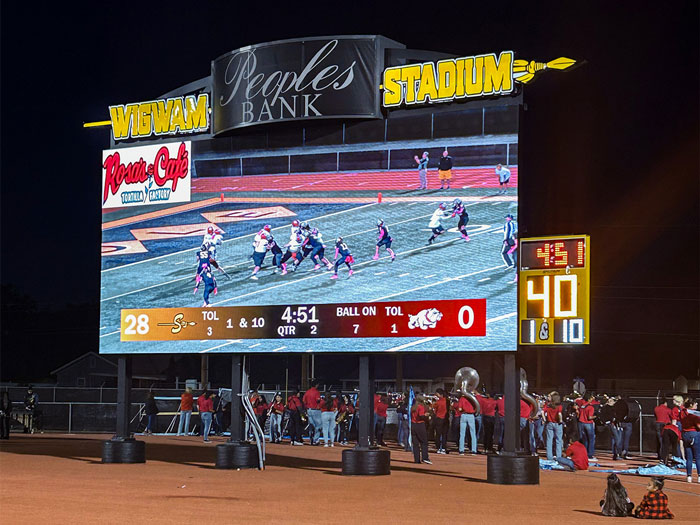Greg Poynor’s videoboard story is an example of wins all around when an organization upgrades its facility sound, lighting and scoreboards. Poynor, the athletic director and head football coach at Seminole High School in Seminole, Texas, worked with local businesses who approached him about the benefits of digital video scoreboards at the school’s 5,000-capacity Wigwam Stadium and 2,000-seat Leland Caffey Court gymnasium.
Of course, an idea sparked by businesses would boost merchants, but Poynor said the enhancements for fans and students are just as impactful.
“School officials were excited about how these videoboards could elevate school spirit and create a more engaging environment for students and fans,” said Poynor. “Local businesses quickly saw the value in connecting with a captive audience, leading to rapid sponsorship commitments. In no time, we secured enough interest to confidently move forward with the purchase and installation of the scoreboards.
“What made this project even more special was the opportunity it provided for our students. The programming and operation of these videoboards are heavily student-driven, offering them on-the-job training and real-world experience in a rapidly growing field. This hands-on involvement has effectively added a new dimension to our curriculum, equipping students with valuable skills in digital media and event production.”
Poynor said the messages displayed throughout games are not only for sponsors, but also showcase student achievements and promote upcoming events.“This project not only enhanced our athletic facilities, but also strengthened the bond between the school and the local community while providing students with valuable learning opportunities,” he said.
Jeff Morgan, a national sales director for the Danville, Ill.-based company that provided the Seminole videoboards, said the effects go beyond gamedays. It was hard to engage much in the days of manual scoreboards and PA systems, he said.
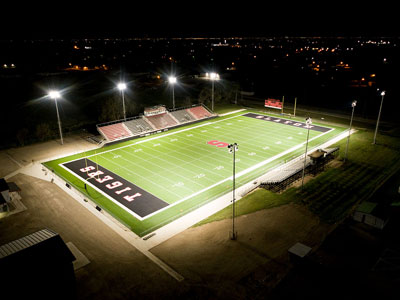
“Stadiums are now equipped with advanced video and audio systems that support a wide range of events beyond just sports, such as concerts, graduations and movie nights,” Morgan said. “This evolution underscores the shift from seeing these technologies as mere gameday additions to viewing them as valuable community assets that enhance overall engagement and provide versatile uses year-round.”
Morgan said he often sees clients become intimidated by the huge advances in the technology—both in hardware and software—that make today’s digital video scoreboards special. He stressed patience, practice and education once a board is installed.
“We encourage clients to see their investment as a long-term asset that will evolve with their needs,” he said.
“Understanding and utilizing the full range of features takes time and experience. Investing in continuous training, support and patience will help clients gradually discover and leverage the technology’s full potential, maximizing its benefits over time.
“Modern game operations software is feature-rich yet user-friendly, allowing for quick training and ease of use. This means that new users can quickly become proficient with the technology, facilitating smoother transitions and maximizing the benefits of the system.”
Because these state-of-the-art installations can be quite expensive, Morgan said there are keys to maximizing the investment:
Don’t:
- Focus solely on the initial price. Consider the long-term value and capabilities of the technology.
- Settle for lower quality or downgrade your requirements to fit a budget. It’s better to wait until you can afford the full solution you need to avoid buyer’s remorse.
- Neglect the planning and integration phase. Proper preparation is key to successful implementation and optimal use of your new system.
Do:
- Allow sufficient time for installation and integration. Aim to complete the setup at least one month before your first major event to ensure everything is functioning properly and your team is well-prepared and comfortable.
- Invest in ongoing training and support to maximize the benefits of your new technology.
“The return on investment for advanced technology largely depends on how effectively it is used,” said Morgan. “Investing time and resources into training, content development and community engagement will yield a higher ROI. The more you put into utilizing and managing the technology, the greater the benefits you’ll see.
“View the technology as a long-term investment rather than a short-term expenditure. When properly maintained and
continuously integrated into your operations, it will provide lasting benefits and support your goals for years to come.”
These types of scoreboards have a home in aquatic facilities as well, said Tac Doran, a project manager for a scoreboard provider based in Loveland, Colo. Doran said the past 20 years have seen rapid evolution from few active scoreboards in natatoriums to few without at least numeric scoreboards to the rise of matrix LED displays that could show alpha-numeric data as well as graphics.
“(These) were largely relegated to larger venues with large budgets as these displays were extremely costly and required a knowledgeable staff to operate,” said Doran.
Few lighting colors on these displays made way for multi-colors about a decade ago; these displays could show graphics and video as well as act as an aquatics scoreboard, said Doran.
As costs began to drop, more facilities installed them, and five years ago LED video displays became the go-to method of
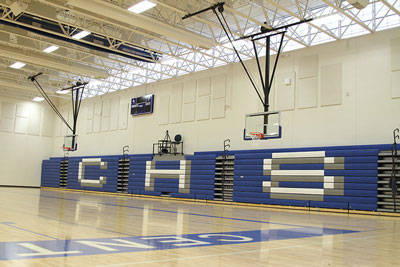
displaying aquatic scoring as facilities realized that they could be used for so much more than just scoring and timing.
The newest version of these video displays can broadcast from any device that has a video output. Things like streaming boxes, cable TV, PCs, videogame consoles and even phones and tablets can all be set up to use the large LED video display just like you would a home TV.
“Facilities started to use them during all open hours for informational slides and short informational videos and even using them as training tools during practices for video replay and analysis for the athletes,” Doran said. “Pixel pitches started to come down to 6-millimeter to 10-millimeter spacing, which gives the users higher-resolution displays for roughly the same price the larger pitches were five years previous.”
Doran suggests that facilities considering a modern aquatics scoreboard know exactly how they want to use one, number
of and what kind of meets per year, what content they want to display other than times and names, and to realize that depending on the board’s location, changes to the electrical system may be required as LED boards use more power.
Lower-budget setups usually are on-deck portable timing systems with either a permanently mounted numeric scoreboard or a portable scoreboard on a caddy. “A lot of times systems like this are shared between local facilities that may not have a budget, or need, for a dedicated system for each pool,” said Doran.
More expensive setups are almost always permanent in deck timing components with dedicated meet management rooms where video and audio production/distribution equipment is installed, he said.
“High-budget systems more and more are for multi-display facilities where they may have a large main video display with smaller auxiliary displays around the facility,” Doran said. “One of our customers has 12-foot tall by 48-foot wide main LED video display with two 12-foot tall by 7-foot wide auxiliary displays for use as record boards as well as water polo and diving scoreboards.”
Doran said when planning for a videoboard, facilities don’t have to be able to afford the larger or more state-of-the-art systems right away. “Plan for the future,” he said. “Even if budget doesn’t allow for equipment now, put in the infrastructure as it is more costly to do it later.”
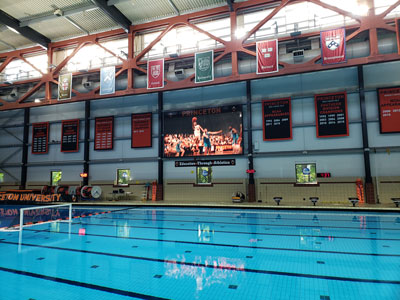
Also, said Doran, don’t be too attracted to the lowest-price options, because they usually come with risks that the buyers may not be willing to accept down the road. LED video displays are a perfect example of this, he said.
“The market is literally getting flooded with extremely low-priced options, but I can guarantee most of those low-priced
options are not built for an aquatic environment, nor will the company likely be around in a few years to support the product,” Doran said.
“Industry standard for video displays is to include a 3% spare parts package with the display. Absolute best method I have found to identify companies to stay away from is if they are ‘giving’ you an extremely large spare parts package for free. I guarantee they won’t be around in a year or two, and the LED display most likely will not be working either.”
A facility’s sound system needs some due diligence as well, said Cooper Hedden, a regional sales manager for a sound system provider based in Gainesville, Ga. Don’t buy without hearing, he said. “Far too often I see venues that were promised the world, only to have the actual performance be much less,” Hedden said. “I would highly encourage any end-user to have their space modeled and hold demonstrations of the product in the space. Have the space modeled, but don’t trust just the computer model as it can be told to say whatever the contractor wants it to. Be sure to hear the product, preferably in your space or a similar install.”
Hedden said when upgrading or installing a new sound system, some considerations should be basic. What does the end user want to accomplish now and five to 10 years down the road? The more that expectations can be established up front, he said, the smoother the process will be.
“What is the expected loudness? Coverage area? Placement of speakers? Does structure need to be added?” Hedden said. “What is the realistic cost of the project? This cost goes beyond just the loudspeakers and includes things like: Will there need to be structure added? What conduit and power circuits need to be added? And labor to install the products? Look at it as a total system cost instead of a simple number.”
Make sure to buy more power than you need initially, Hedden said, because having a system that is running at 100% capacity all the time leads to issues down the road.
Matt Starr, CEO of a company that provides portable and modular power and timers and scoreboards, said one way to save money is to invest in modular systems that can be expanded or upgraded over time. “This allows you to start with a solid foundation and add more features as the budget allows, without having to replace the entire system,” said Starr. “Additionally, regular maintenance can extend the lifespan of your equipment, reducing the need for costly repairs or replacements. It’s also wise to explore financing options or grants that may be available for large capital expenditures like sound systems or scoreboards.”
Because of the advancement of sound and lighting systems to enhance the experience of events, planning is ever more important, said Rob DeHart, president of a California-based audio-visual provider.
Over the years technology has improved to the point where most installations have a centralized room where all of the brains of the sound system exist, and audio is sent to all the different areas of the facility with specialized controls in the rooms.
“When planning a project for a facility, it’s all about working with your sound designer to get exactly what you want,” said DeHart. “Commonly it can take a year in planning if the project is built from ground up. Plan ahead. Start early. Give yourself plenty of time for lots of input from your staff or designers. When planning ahead you have the advantage of securing all the equipment necessary for the project, rather than waiting for parts to come in.”
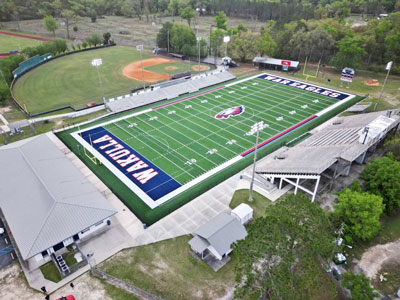
Jenny Wagner can not only control the lights of her school’s stadium with an app on her phone on gamedays, she can preset those lights for each game before the season starts. She said in order to satisfy her most important priorities in sound, lighting and scoreboards, she highly values communication with the providers.
“I think the most important aspects for each of these three items is ease of use, reliability and customer service,” said Wagner, activities administrator and assistant principal for Centennial Public School in Utica, Neb. “I want all of these things to be top priority with any product I’m working with because it makes the ability to do my job well that much easier.”
For instance, the provider of Centennial’s video scoreboards not only does the minimum of providing equipment, installing it and training school staff to operate it, but also helps with a revenue-generating plan, said Wagner. It’s important to take time with the search for the right provider partner, she said, and to remember that the customer is in control.
“One of the biggest lessons I’ve learned is to be willing to try different products and get demos from different companies and vendors for the products to ensure that I’m using the product that works best for me and my facilities,” Wagner said.
“Do not be afraid of hearing a no or telling someone no—if you’re wanting to bring a new system into your school and need to raise funds to provide for this, don’t be afraid to hear no’s from companies because you will never know what they say if you don’t ask—you might be surprised and get more yeses than nos. Don’t be afraid of telling a vendor that their product isn’t right for your facility—you do need to make sure you get what you want so you will utilize it to make your job easier in the long run.”
Poynor gave an example of the kind of exceptional service end users should insist on. When his videoboard provider installed the unit, it did so on a deadline.
“They worked efficiently, understanding the urgency of getting the videoboards installed and operational in time for our next game, which happened to be Homecoming,” he said. “Their team remained on-site during the game, providing hands-on support to ensure everything ran smoothly. This was particularly important as our team was still getting familiar with the new technology.”
Kyle Sedow, market manager for K-12 education, parks & recreation, and two-year colleges for a videoboard provider based in Brookings, S.D., said there are dos and don’ts for potential clients:
- Do your homework with vendors and go see their headquarters. Your investment is large, and you should know the ins and outs of who you are working with.
- Do have your long-term goals in mind when selecting a vendor. Make your selection based on what you want out of the system and not just the price of one vendor to the next. The biggest value difference is found after you have the system for a few years.
- Don’t buy for today. A new scoring/video/sound system should last 10-plus years, and you need to buy a system that represents your brand for the next 10 years. Buying too small may be viewed as a negative in two to three years.
One of the new technological capabilities around amateur sports is the prevalence of streaming events. The cameras for the streaming can only provide the best quality viewing with the best available lighting, said James D. McCarty, president of U.S operations for a lighting provider based in Dayton, Ohio.
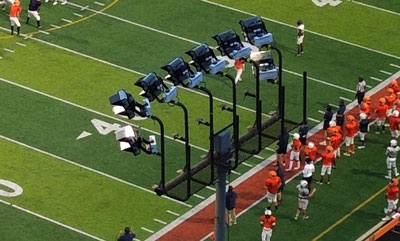
“Most high school events in the U.S. have some level of streaming,” he said. “Streaming allows interested fans and family to watch games remotely, it is a potential revenue stream for schools and organizations, and it is also a valuable tool for scouting opponents and recruiting athletes. One of the challenges with streaming in many of the old, bulb-lit facilities is the minimal amount of vertical light levels for the cameras. With the old, hyper focus of offsite spill and glare with the bulb technology, much of the light was aimed at a low, horizontal level. Good LED sports lighting, with its precision, can add the needed vertical lighting for effective streaming and players names and numbers can be seen clearly (and) the ball can be seen in the air.”
LED lighting has taken over the illumination game, indoors and out, said McCarty, with not only superior quality of lighting but also energy savings, especially indoors, where the lighting is used much more than outdoors. He recommends those needing an upgrade or new construction lighting seek only established professionals, especially when an outdoor system is being upgraded, because of all the infrastructure involved.
“The best practice is to have a professional structural evaluation of your existing infrastructure prior to switching out lighting systems,” he said. “There are many companies out there who skip this step or tell customers that it is not necessary because it will add some cost to the project. Our opinion is that this is a big ‘don’t.’ Simply observing, with the human eye, the conditions of poles and foundations, welds and hardware is not enough. Bring in professionals with equipment and knowledge.”
To maximize light usage, providers can offer site analysis as well as smart controls, said Shahil Amin, a vice president of a lighting provider based in Charlotte, N.C. Overlooking uniformity in lighting distribution is a common mistake, Amin said.
“Some clients focus solely on brightness and neglect the importance of even light distribution across the entire playing area, leading to shadows or hot spots that can affect gameplay,” he said. “To combat that, we conduct detailed lighting simulations and on-site assessments to ensure uniform illumination, eliminating any potential for shadows or uneven lighting.”
Amin said another frequent end user error is ignoring the impact of glare and light spill. Poorly designed lighting can cause glare that distracts players or light spill that affects nearby areas, leading to complaints from the community or even regulatory issues.
“To help with this we use advanced optics to control light distribution, reducing glare and light spill to ensure compliance with local regulations and improve player and spectator experience,” said Amin. “We are able to control the light exactly
where it needs to be, without lighting up the neighbors, or surrounding areas.” RM



